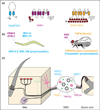Mammalian somatosensory mechanotransduction
- PMID: 19683913
- PMCID: PMC4044613
- DOI: 10.1016/j.conb.2009.07.008
Mammalian somatosensory mechanotransduction
Abstract
In the mammalian somatosensory system, mechanosensitive neurons mediate the senses of touch and pain. Among sensory modalities, mechanosensation has been the most elusive with regard to the identification of transduction molecules. One factor that has hindered the identification of transduction molecules is the diversity of neurons; physiological studies have revealed many subtypes of neurons, specialized to detect a variety of mechanical stimuli. Do different subtypes use the same transduction molecules that are modified by cellular context? Or, are there multiple mechanotransducers that specialize in sensing different mechanical stimuli? This review highlights recent progress in identifying and characterizing candidate molecular force transducers, as well as the development of new tools to characterize touch transduction at the molecular, cellular, and behavioral levels.
Figures

References
-
- Tominaga M, Caterina MJ. Thermosensation and pain. J Neurobiol. 2004;61:3–12. - PubMed
-
- Walker RG, Willingham AT, Zuker CS. A Drosophila mechanosensory transduction channel. Science. 2000;287:2229–2234. - PubMed
-
-
O’Hagan R, Chalfie M, Goodman MB. The MEC-4 DEG/ENaC channel of Caenorhabditis elegans touch receptor neurons transduces mechanical signals. Nat Neurosci. 2005;8:43–50. This study presents the first whole-cell recordings of mechanotransduction currents from C. elegans sensory neurons. The authors characterize the speed (<1 ms), conductance (25 pS) and selectivity (Na+) of transduction channels in body touch neurons. Recordings from mutants demonstrate that the MEC-4 complex carries the transduction current. See also Suzuki et al. [7] for in vivo imaging of touch-evoked responses.
-
-
- Syntichaki P, Tavernarakis N. Genetic models of mechanotransduction: the nematode Caenorhabditis elegans. Physiol Rev. 2004;84:1097–1153. - PubMed
Publication types
MeSH terms
Substances
Grants and funding
LinkOut - more resources
Full Text Sources

